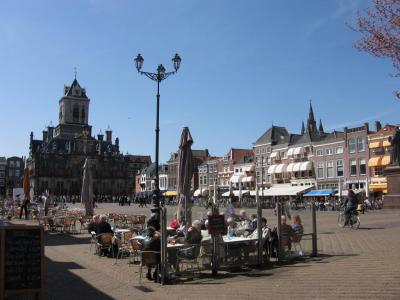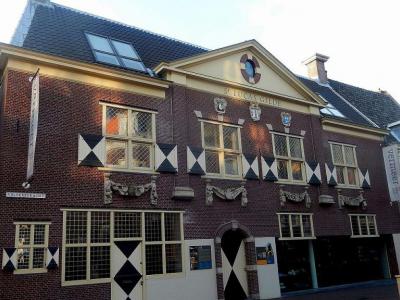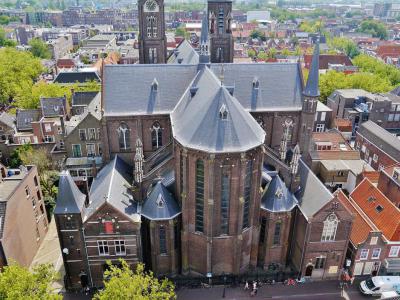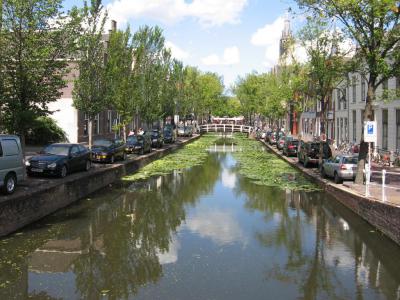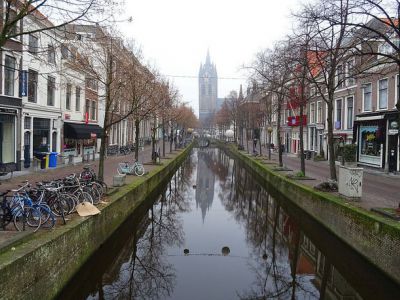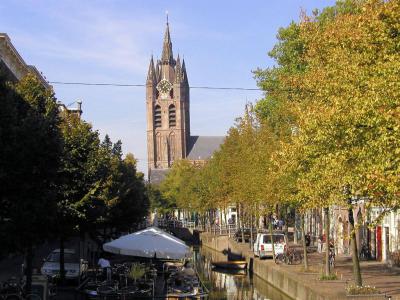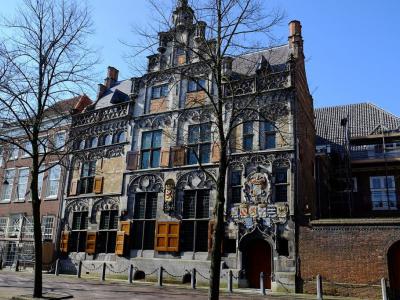
Delft Introduction Walking Tour (Self Guided), Delft
The word "delven" in Dutch means "to dig." The town of Delft began in 1075 when a nobleman decided to build his dream manor where a canal crossed the silted up river Gantel. A settlement became a market town with a large market square. The town was called "Delft."
Canals were vital to Delft. Flat-bottomed boats brought in products, fuel and people. In 1246 Count Willem II granted a city charter. In 1389 the waterways reached the river Maas and Delft had its own seaport, Delfshaven.
In 1581 Willam of Orange, also known as William the Silent, moved into the convent of St. Agatha in Delft, later called the Prinsenhof. William was the leader of Dutch resistance against Philip II of Spain. This was the time of the Eighty Years War.
Delft managed to repel the Spanish in the Battle of Delft in 1573 and in 1581 Delft became the default capital of independent Netherlands. William would pay for this independence with his life.
King Philip II offered a reward of 25,000 crowns to anyone who killed William the Silent. In 1584 one Balthazar Gerards assassinated William in the Prinsenhof. Gerards was captured and executed brutally. The Prinsenhof is now a museum. William was buried in the New Church (Nieuwe Kerk) of Delft. He is known in Netherlands as the "Father of the Fatherland".
In the 17th century, independent Delft grew into its "Golden Age." The Dutch East India Company opened in Delft in 1602 and the famous Delft Blue China made its appearance.
A generation of celebrated artists made the scene, including: Leonard Bramer, Carel Fabritus, Pieter de Hoogh, Emanuel de Witte, Jan Steen, and last but not the least, Johannes Vermeer. Reinier de Graaf and Antoni van Leeuwenhoek took the lead in scientific research.
The center of the city retains its medieval and renaissance buildings, canals and bridges. Historical sights include: The Old Church (Oude Kerk); The New Church (Nieuwe Kerk), containing the royal family crypt; the Prinsenhof; The Town Hall and the spacious Main Square; and centuries old buildings.
Come to the Old Canal where it all began. Flag down a water taxi and explore Delft, the city of art, science and independence.
Canals were vital to Delft. Flat-bottomed boats brought in products, fuel and people. In 1246 Count Willem II granted a city charter. In 1389 the waterways reached the river Maas and Delft had its own seaport, Delfshaven.
In 1581 Willam of Orange, also known as William the Silent, moved into the convent of St. Agatha in Delft, later called the Prinsenhof. William was the leader of Dutch resistance against Philip II of Spain. This was the time of the Eighty Years War.
Delft managed to repel the Spanish in the Battle of Delft in 1573 and in 1581 Delft became the default capital of independent Netherlands. William would pay for this independence with his life.
King Philip II offered a reward of 25,000 crowns to anyone who killed William the Silent. In 1584 one Balthazar Gerards assassinated William in the Prinsenhof. Gerards was captured and executed brutally. The Prinsenhof is now a museum. William was buried in the New Church (Nieuwe Kerk) of Delft. He is known in Netherlands as the "Father of the Fatherland".
In the 17th century, independent Delft grew into its "Golden Age." The Dutch East India Company opened in Delft in 1602 and the famous Delft Blue China made its appearance.
A generation of celebrated artists made the scene, including: Leonard Bramer, Carel Fabritus, Pieter de Hoogh, Emanuel de Witte, Jan Steen, and last but not the least, Johannes Vermeer. Reinier de Graaf and Antoni van Leeuwenhoek took the lead in scientific research.
The center of the city retains its medieval and renaissance buildings, canals and bridges. Historical sights include: The Old Church (Oude Kerk); The New Church (Nieuwe Kerk), containing the royal family crypt; the Prinsenhof; The Town Hall and the spacious Main Square; and centuries old buildings.
Come to the Old Canal where it all began. Flag down a water taxi and explore Delft, the city of art, science and independence.
How it works: Download the app "GPSmyCity: Walks in 1K+ Cities" from Apple App Store or Google Play Store to your mobile phone or tablet. The app turns your mobile device into a personal tour guide and its built-in GPS navigation functions guide you from one tour stop to next. The app works offline, so no data plan is needed when traveling abroad.
Delft Introduction Walking Tour Map
Guide Name: Delft Introduction Walking Tour
Guide Location: Netherlands » Delft (See other walking tours in Delft)
Guide Type: Self-guided Walking Tour (Sightseeing)
# of Attractions: 13
Tour Duration: 2 Hour(s)
Travel Distance: 2.0 Km or 1.2 Miles
Author: Caroline
Sight(s) Featured in This Guide:
Guide Location: Netherlands » Delft (See other walking tours in Delft)
Guide Type: Self-guided Walking Tour (Sightseeing)
# of Attractions: 13
Tour Duration: 2 Hour(s)
Travel Distance: 2.0 Km or 1.2 Miles
Author: Caroline
Sight(s) Featured in This Guide:
- Markt (Market Square)
- Town Hall
- Vermeer Centre
- Nieuwe Kerk (New Church)
- Beestenmarkt (Animal Market)
- Maria van Jesse Church
- Brabantse Turfmarkt (Brabant Peat Market)
- Breestraat (Bree Street)
- Museum Paul Tétar van Elven
- Old Canal
- Oude Kerk (Old Church)
- Gemeenlandshuis (Water Board House)
- Museum Het Prinsenhof (Court of the Prince Museum)
1) Markt (Market Square) (must see)
The name "Delft" derives from the word to dig. The digging relates to a canal across the creek wall of the shallow Gantel river. A manor was built here in the year 1075. It was a good place for an important market town of the middle ages. From its beginnings until today, the vast Market Square has been the center of town.
Bordering the square are the Renaissance Town Hall and the 16th century New Church, the Gothic resting place of the royal families of the Netherlands. Near the New Church is the statue of Hugo Grotius, humanist, jurist, poet and playwright of the 16th and 17th centuries.
Visitors to Delft inexorably wind up on the Market Square. It is essentially the center of the old town. Thursdays are market days. The square is jammed with at least 150 covered stalls, offering flowers, vegetables, tasty cheeses, hand-crafted souvenirs, fresh bread, antiques, books and jewelry.
The square also offers clothing, bicycle parts, and electronics. There are pubs and fresh-air terraces, cafes and restaurants. Shoppers, visitors and locals bargaining and tasting together, hip and thigh. One can browse the kiosks, sample cheeses and try out the stoopwaffles.
Bordering the square are the Renaissance Town Hall and the 16th century New Church, the Gothic resting place of the royal families of the Netherlands. Near the New Church is the statue of Hugo Grotius, humanist, jurist, poet and playwright of the 16th and 17th centuries.
Visitors to Delft inexorably wind up on the Market Square. It is essentially the center of the old town. Thursdays are market days. The square is jammed with at least 150 covered stalls, offering flowers, vegetables, tasty cheeses, hand-crafted souvenirs, fresh bread, antiques, books and jewelry.
The square also offers clothing, bicycle parts, and electronics. There are pubs and fresh-air terraces, cafes and restaurants. Shoppers, visitors and locals bargaining and tasting together, hip and thigh. One can browse the kiosks, sample cheeses and try out the stoopwaffles.
2) Town Hall
In 1618 The old City Hall of Delft burned down. That was a bad thing. A good thing was Hendrik de Keyser, Dutch Mannerist architect and sculptor was found across the Market Square. He was working on the tomb of William the Silent in the New Church. Before the ashes were cool, he was asked to design a replacement city hall.
The Gothic belfry tower was spared by the fire. Built in the 13th century, its ornate clock faces were installed in 1536 by Hendrick van Trier and Francois Hemony. It is faced with Wallonia limestone and is commonly called "The Stone." Only the tower of the Town Hall escaped the fire. It was used as a prison. It is a museum of prison artifacts today.
William of Orange, founder of the royal House of Orange, was assassinated in 1584 in his residence at the Prinsenhof by Balthasar Gerard, an operative of the King of Spain. Gerard was captured and held in the tower prison. He was later executed after being tortured. All this violence in the name of religion.
Herndrik was able to focus his efforts on the hall proper. He chose a Renaissance style. Since 1618 the building has been changed several times. It was restored to Hendrik de Keyser's original style in the 20th century. The Town Hall now houses the offices of the Delft city council. It is still today a venue for civic wedding ceremonies.
The Gothic belfry tower was spared by the fire. Built in the 13th century, its ornate clock faces were installed in 1536 by Hendrick van Trier and Francois Hemony. It is faced with Wallonia limestone and is commonly called "The Stone." Only the tower of the Town Hall escaped the fire. It was used as a prison. It is a museum of prison artifacts today.
William of Orange, founder of the royal House of Orange, was assassinated in 1584 in his residence at the Prinsenhof by Balthasar Gerard, an operative of the King of Spain. Gerard was captured and held in the tower prison. He was later executed after being tortured. All this violence in the name of religion.
Herndrik was able to focus his efforts on the hall proper. He chose a Renaissance style. Since 1618 the building has been changed several times. It was restored to Hendrik de Keyser's original style in the 20th century. The Town Hall now houses the offices of the Delft city council. It is still today a venue for civic wedding ceremonies.
3) Vermeer Centre (must see)
The Vermeer Centre in Delft is an information center dedicated to one of the most prominent Dutch painters of the Golden Age, Johannes Vermeer. Opened in 2007 and run entirely by volunteers, this popular cultural venue is found in the historic former Saint Luke Guild House, and is the only place in the world where all 37 paintings by Vermeer can be seen as full-size reproductions.
Pursuant to its objective – to disseminate knowledge about Delft during the lifetime of Vermeer (1632 – 1675), the center works with local archaeological groups and heritage organizations. Although it acts as a museum, the Vermeer Centre does not own the displayed items.
The exhibits are spread on three floors, including the basement, allowing visitors an insight into Vermeer's life reflected in his works as well as those of his contemporaries, much as to learn about the events that occurred during his lifetime.
Other than the paintings, the permanent exhibition comprises various media including a studio which explores methods of Vermeer's work – his attention to color, light and perspective. Here, visitors have the opportunity to pose for a picture as Lady Writing a Letter with her Maid, as well as to see a video on a 12-meter-wide screen highlighting the relationship between the artist and the city of Delft.
On the ground floor you can find a small gift store and a bookshop. The exhibition "Vermeer's Messages of Love" on the top floor examines symbolism in his paintings.
Tip:
For individual visitors there is a free audio tour.
Pursuant to its objective – to disseminate knowledge about Delft during the lifetime of Vermeer (1632 – 1675), the center works with local archaeological groups and heritage organizations. Although it acts as a museum, the Vermeer Centre does not own the displayed items.
The exhibits are spread on three floors, including the basement, allowing visitors an insight into Vermeer's life reflected in his works as well as those of his contemporaries, much as to learn about the events that occurred during his lifetime.
Other than the paintings, the permanent exhibition comprises various media including a studio which explores methods of Vermeer's work – his attention to color, light and perspective. Here, visitors have the opportunity to pose for a picture as Lady Writing a Letter with her Maid, as well as to see a video on a 12-meter-wide screen highlighting the relationship between the artist and the city of Delft.
On the ground floor you can find a small gift store and a bookshop. The exhibition "Vermeer's Messages of Love" on the top floor examines symbolism in his paintings.
Tip:
For individual visitors there is a free audio tour.
4) Nieuwe Kerk (New Church) (must see)
The New Church came after the Old Church. No surprise there. The very first New Church was temporary, made of wood in 1381 and consecrated in 1382. The Gothic stone basilica New Church structure was begun in 1384 and the inner wooden church was disassembled. The church is on the Market Square, opposite the Town Hall.
The tower, designed by Jacob van de Borch, was not started until 1396. It was slow building, finished in 1496. The tower was ill-fated. In May, 1536, a lightning strike on the tower started a blaze that nearly consumed the entire town. The city archives went up in smoke, resulting in the loss of close to all public records before 1536.
Bad luck came back again. 1654 was the year of the Delft Thunderclap. A gunpowder storage magazine in the northeast corner of town exploded. The center of the city was erased and the New Church did not escape damage. All the stained glass windows in the church disintegrated. The next magazine was situated well out of town.
In 1872 the church tower attracted lightning once again. Pierre Cuypers, architect, designed a new tower strengthened with Benteimer sandstone. Pierre also replaced the spire, making the New Church the tallest in the Netherlands after the Dom Tower in Utrecht. The tower can be climbed using no less than 356 steps.
The New Church was a Roman Catholic church named for the Virgin Mary and Saint Ursula of Cologne. The Reformation changed all that in 1572, when the New Church was usurped by the Dutch Reformed Church. In 2004 the Dutch Reformed Church merged with other Protestant churches to form the Protestant Church of the Netherlands.
For centuries, the New Church has been the burial place for members of the House of Orange-Nassau. The first of them, William the Silent, was entombed in a mausoleum in 1584. The latest burial – of Queen Juliana and her husband Prince Bernhard – took place in 2004. The royal family crypt is private and not open to the public.
The native of Delft painter Johannes Vermeer, christened in the New Church on October 31, 1632, had pictured this church's tower in his masterful landscape “View of Delft”. Notably, in his painting the bells are not yet seen. According to the independent Dutch art historian Kees Kaldenbach, the delivery of carillon for the New Church started in 1660 and was completed in the summer of 1661, which corresponds with the dating previously suggested, based on Vermeer's painting.
A historical chronicle says that the 36 bells installed in the New Church were "the latest piece of technology." Their music must have been a source of constant pleasure to Vermeer's ears, who would have heard them every day from his nearby studio.
The tower, designed by Jacob van de Borch, was not started until 1396. It was slow building, finished in 1496. The tower was ill-fated. In May, 1536, a lightning strike on the tower started a blaze that nearly consumed the entire town. The city archives went up in smoke, resulting in the loss of close to all public records before 1536.
Bad luck came back again. 1654 was the year of the Delft Thunderclap. A gunpowder storage magazine in the northeast corner of town exploded. The center of the city was erased and the New Church did not escape damage. All the stained glass windows in the church disintegrated. The next magazine was situated well out of town.
In 1872 the church tower attracted lightning once again. Pierre Cuypers, architect, designed a new tower strengthened with Benteimer sandstone. Pierre also replaced the spire, making the New Church the tallest in the Netherlands after the Dom Tower in Utrecht. The tower can be climbed using no less than 356 steps.
The New Church was a Roman Catholic church named for the Virgin Mary and Saint Ursula of Cologne. The Reformation changed all that in 1572, when the New Church was usurped by the Dutch Reformed Church. In 2004 the Dutch Reformed Church merged with other Protestant churches to form the Protestant Church of the Netherlands.
For centuries, the New Church has been the burial place for members of the House of Orange-Nassau. The first of them, William the Silent, was entombed in a mausoleum in 1584. The latest burial – of Queen Juliana and her husband Prince Bernhard – took place in 2004. The royal family crypt is private and not open to the public.
The native of Delft painter Johannes Vermeer, christened in the New Church on October 31, 1632, had pictured this church's tower in his masterful landscape “View of Delft”. Notably, in his painting the bells are not yet seen. According to the independent Dutch art historian Kees Kaldenbach, the delivery of carillon for the New Church started in 1660 and was completed in the summer of 1661, which corresponds with the dating previously suggested, based on Vermeer's painting.
A historical chronicle says that the 36 bells installed in the New Church were "the latest piece of technology." Their music must have been a source of constant pleasure to Vermeer's ears, who would have heard them every day from his nearby studio.
5) Beestenmarkt (Animal Market) (must see)
The Animal Market has gone through at least three major incarnations. At first, in the period 1449 to 1595 there were no beasties and no market. There was only Franciscan monastery cloister.
By 1595 the Protestant Reformation had come to town and the Monks were passe. The cloister evaporated and a square was formed. What to do with it? How about an animal market? Yes, in 1595 the square became the Animal Market. It was the place for the Westland farmers from South Holland province to buy and sell their cattle.
Trading began when the bell rang. A "Sheep Bell" was installed at number 9 on the market square in 1734. By 1972, with the help of foot-and-mouth disease, the animal market was passe.
The square is pedestrian, with walkways surrounding a raised, paved area shaded by plane trees. In the center is an earthenware sculpture of a bull by artist Rob Brandt. In the winter the square becomes an ice-skating rink.
The family of artist Vermeer once lived at the house known as The Three Hammers at Animal Market number 26. The ground floor of 26 is now a pub. The square is lined with a variety of pubs, cafes and restaurants. In the summer the cafes have terraces in the square. Live music in the square is not uncommon.
By 1595 the Protestant Reformation had come to town and the Monks were passe. The cloister evaporated and a square was formed. What to do with it? How about an animal market? Yes, in 1595 the square became the Animal Market. It was the place for the Westland farmers from South Holland province to buy and sell their cattle.
Trading began when the bell rang. A "Sheep Bell" was installed at number 9 on the market square in 1734. By 1972, with the help of foot-and-mouth disease, the animal market was passe.
The square is pedestrian, with walkways surrounding a raised, paved area shaded by plane trees. In the center is an earthenware sculpture of a bull by artist Rob Brandt. In the winter the square becomes an ice-skating rink.
The family of artist Vermeer once lived at the house known as The Three Hammers at Animal Market number 26. The ground floor of 26 is now a pub. The square is lined with a variety of pubs, cafes and restaurants. In the summer the cafes have terraces in the square. Live music in the square is not uncommon.
6) Maria van Jesse Church
By 1572 the Netherlands had turned to Protestantism. The Catholic Church was effectively a thing of the past if not actually banned in most places. Delft, however was more tolerant than most cities. Holy mass could still be heard in the center of the town known as "The Pope's Corner." The Jesuits even managed to build a church by 1733.
Referred to as the Shelter Church, it was unassuming and hidden from view. The structure was situated at the west side of the present Maria van Jesse Church. It was formally known as Saint Jozef's. During the French occupation of Delft a new bigger church designed by architect Peter Adams was built.
After 1848 Dutch Catholics regained religious rights and in 1875 Adams' work was replaced in 1882 by the enormous Neo-Gothic building designed by Everard Margry. Margry was the most prolific students of Pierre Cuypers. The building has three aisles in a cruciform layout and a vaulted ceiling above the nave.
The towers by the entrance have elements resonant with both the old and new churches. The pulpit, designed by Jos Tonnaer, dates from 1903. The Altarpiece, from 1905, is by Anthony van Ljsendijck.
The two Catholic parishes of Delft were merged in 1971 and Saint Jozef's was renamed Maria van Jesse Church. The church has been a national monument since 1982.
Referred to as the Shelter Church, it was unassuming and hidden from view. The structure was situated at the west side of the present Maria van Jesse Church. It was formally known as Saint Jozef's. During the French occupation of Delft a new bigger church designed by architect Peter Adams was built.
After 1848 Dutch Catholics regained religious rights and in 1875 Adams' work was replaced in 1882 by the enormous Neo-Gothic building designed by Everard Margry. Margry was the most prolific students of Pierre Cuypers. The building has three aisles in a cruciform layout and a vaulted ceiling above the nave.
The towers by the entrance have elements resonant with both the old and new churches. The pulpit, designed by Jos Tonnaer, dates from 1903. The Altarpiece, from 1905, is by Anthony van Ljsendijck.
The two Catholic parishes of Delft were merged in 1971 and Saint Jozef's was renamed Maria van Jesse Church. The church has been a national monument since 1982.
7) Brabantse Turfmarkt (Brabant Peat Market)
The Brabant Peat Market can be found just off the Old Canal which runs north to south in the city of Delft. The street merges into the street Achterom which connects to the Old Canal and the little harbor of Kolk. The Old Canal was dug around 1100 AD. It formed the eastern boundary of the city in the 13th century.
Products, produce and peat could be brought into the city by flat bottomed boats powered by poles. Peat was a vital fuel. It burned slowly, giving off little exhaust gasses. It was the power fuel of Delft industries from the 15th to the 19th centuries.
The northern parts of the Peat Market and the Burgwal Canal were filled in 1860 to accommodate the enlarged Animal Market.
These days one cannot get peat at the Peat Market but nearly everything else is available. Thursdays and Saturdays are market days at Brabant Peat Market. Flowers, fruits, vegetables, cheeses, clothing and household goods are plentiful and so are the crowds.
Products, produce and peat could be brought into the city by flat bottomed boats powered by poles. Peat was a vital fuel. It burned slowly, giving off little exhaust gasses. It was the power fuel of Delft industries from the 15th to the 19th centuries.
The northern parts of the Peat Market and the Burgwal Canal were filled in 1860 to accommodate the enlarged Animal Market.
These days one cannot get peat at the Peat Market but nearly everything else is available. Thursdays and Saturdays are market days at Brabant Peat Market. Flowers, fruits, vegetables, cheeses, clothing and household goods are plentiful and so are the crowds.
8) Breestraat (Bree Street)
Shopping in Delft is said to be the best. One reason for this might be that most of the shopping areas in the Old City center are vehicle free. The underground parking helps too. Shops and boutiques are sandwiched between old monuments, squares and canals. Delft has been voted one of the top ten Dutch shopping cities annually.
Bree Street, along with Brabant Peat Market, Burgwal, Gashuislaan, and Moislaan offer a wide range of shopping experiences. From Bree Street its just a quick walk to bigger, more modern outlets located in newer parts of the town. That's if one still craves the big department store milieu.
The great variety of shops and outlets on Bree Street are surprising. There are art galleries, gift stores, fashion shops, vintage clothing stores and of course, cafes and restaurants for the hungry shoppers. The caveat here is small shops and boutiques don't always keep regular hours.
Bree Street, along with Brabant Peat Market, Burgwal, Gashuislaan, and Moislaan offer a wide range of shopping experiences. From Bree Street its just a quick walk to bigger, more modern outlets located in newer parts of the town. That's if one still craves the big department store milieu.
The great variety of shops and outlets on Bree Street are surprising. There are art galleries, gift stores, fashion shops, vintage clothing stores and of course, cafes and restaurants for the hungry shoppers. The caveat here is small shops and boutiques don't always keep regular hours.
9) Museum Paul Tétar van Elven
In a 16th century canal house on the Corn Market is the art museum of one special man. Paul Tetar van Elven was a painter. He lived from 1823 to 1896. He did scenes from history and portraits. His specialty was copies of Old Masters. The Netherlands and Delft produced many of the best "Old masters" of art.
Paul trained at the Hague and later taught at the Polytechnical School in Delft, which later became the Technical University of Delft. He lived at his canal house from 1864 until 1894. This is where he kept his beloved collections of paintings, furniture, objets d'art, Chinese porcelain and blue faiences.
In 1925 van Elven's second wife and widow, Mrs. Pitlo-van Duuren, willed his collections and the canal house to a museum foundation. The museum, in his name, was opened on June 23, 1927.
Paul trained at the Hague and later taught at the Polytechnical School in Delft, which later became the Technical University of Delft. He lived at his canal house from 1864 until 1894. This is where he kept his beloved collections of paintings, furniture, objets d'art, Chinese porcelain and blue faiences.
In 1925 van Elven's second wife and widow, Mrs. Pitlo-van Duuren, willed his collections and the canal house to a museum foundation. The museum, in his name, was opened on June 23, 1927.
10) Old Canal
A quick walk from the Old City finds the Old Canal, crossing the city from north to south. This is the first canal of Delft. It was dug in 1100 as the town was founded. It extends mainly through the Noordeinde. The canals were primarily made to drain the land. Later they were used for transport of products especially peat.
Delft canals are at a level with the streets, making them unique compared to other canal cities in Europe. Canals in Delft are still used for transportation of people and goods and water management. Water taxis are available as well as private boats. Boats or taxis can be rented by phone or by flagging one down. Delft is best seen by water.
The Old Canal, is a great way to explore the city by day or by night. The canal is lined with picturesque old houses such as the Begijnhof with its late Gothic tower and the "Hidden Shelter Church" built by Daniel Merot in 1743 for persecuted Catholics.
Delft canals are at a level with the streets, making them unique compared to other canal cities in Europe. Canals in Delft are still used for transportation of people and goods and water management. Water taxis are available as well as private boats. Boats or taxis can be rented by phone or by flagging one down. Delft is best seen by water.
The Old Canal, is a great way to explore the city by day or by night. The canal is lined with picturesque old houses such as the Begijnhof with its late Gothic tower and the "Hidden Shelter Church" built by Daniel Merot in 1743 for persecuted Catholics.
11) Oude Kerk (Old Church) (must see)
The Old Church, nicknamed "Old John," is a Gothic Protestant temple in Delft whose most recognizable feature is a 75-meter-high brick tower leaning about two meters from the vertical. The layout followed that of a traditional basilica, with a nave flanked by two smaller aisles. The church was founded as Saint Bartholomew's in 1246 on the site previously occupied by other temples for two centuries.
There are three pipe organs inside the church: the main one (installed in 1857), the north aisle (installed in 1873), and the choir (installed in 1770). The most massive bell in the tower, cast in 1570 and called Trinitasklok or Bourdon, weighs nearly nine tonnes. Because of its strong and potentially damaging vibrations, it is rung only on special occasions, such as the burial of a Dutch royal family member in the nearby New Church.
The Old Church is also notable as the last resting place of Johannes Vermeer – the artist was buried here on 15th December 1675 in a family crypt in the northern transept, bought by his mother-in-law Maria Thins in 1661. His grave remained unmarked for some time because, upon the artist's death, his family had no money for a tombstone.
Today there are two markers for Vermeer's burial site: an austere plaque installed in 1975 to commemorate the 300th anniversary of his death; and a new, more elaborate tombstone, added in 2007, near the western
entrance. This creates a bit of confusion regarding the exact location of Vermeer's tomb. One thing is certain, though, that the artist rests in the company of some truly excellent citizens of Delft.
There are three pipe organs inside the church: the main one (installed in 1857), the north aisle (installed in 1873), and the choir (installed in 1770). The most massive bell in the tower, cast in 1570 and called Trinitasklok or Bourdon, weighs nearly nine tonnes. Because of its strong and potentially damaging vibrations, it is rung only on special occasions, such as the burial of a Dutch royal family member in the nearby New Church.
The Old Church is also notable as the last resting place of Johannes Vermeer – the artist was buried here on 15th December 1675 in a family crypt in the northern transept, bought by his mother-in-law Maria Thins in 1661. His grave remained unmarked for some time because, upon the artist's death, his family had no money for a tombstone.
Today there are two markers for Vermeer's burial site: an austere plaque installed in 1975 to commemorate the 300th anniversary of his death; and a new, more elaborate tombstone, added in 2007, near the western
entrance. This creates a bit of confusion regarding the exact location of Vermeer's tomb. One thing is certain, though, that the artist rests in the company of some truly excellent citizens of Delft.
12) Gemeenlandshuis (Water Board House)
Water management and flood control in Delft in the 16th century was managed through regular checks of the dike systems. The Dike Warden and his crew would meet in the closest house or pub and stay there until the local water management problem was solved. As the city grew, a new approach was needed. So, the Waterboard House came to be.
Water Board House is a building that is used or has been used as a Water Board HQ. The Water Board, as a governing body, needed a building as impressive as the Town Hall. In Delft the Waterboard House is home to the Delfland Water Board. It is a Late-Gothic building located at Old Delft 167. It was built in 1505.
The first owner of the building was Jan de Huyter, a bailiff of Delft. The Delfland Water Board has been housed here since 1645. It has a sandstone facade covered by a generous number of Coats of Arms and shields. Inside is a huge collection of old charts and maps of Delfland.
The building is not open to public, but it is well worth a few photos from the outside.
Water Board House is a building that is used or has been used as a Water Board HQ. The Water Board, as a governing body, needed a building as impressive as the Town Hall. In Delft the Waterboard House is home to the Delfland Water Board. It is a Late-Gothic building located at Old Delft 167. It was built in 1505.
The first owner of the building was Jan de Huyter, a bailiff of Delft. The Delfland Water Board has been housed here since 1645. It has a sandstone facade covered by a generous number of Coats of Arms and shields. Inside is a huge collection of old charts and maps of Delfland.
The building is not open to public, but it is well worth a few photos from the outside.
13) Museum Het Prinsenhof (Court of the Prince Museum) (must see)
The Court of the Prince, known locally as Prinsenhof, began in 1403 as the Catholic monastery of Saint Agatha. The monastery became one of the wealthiest and largest monasteries of Delft. At one time as many as 125 nuns lived in the monastery complex. In 1572 the Protestant Reformation upended things and the monastery was seized and awarded to William of Orange and his forces.
William used part of the Prinsenhof as a residence. He was actively at war with Spanish elements in the lowlands. The King of Spain had posted rewards for his head. On 10 July, 1584, William was shot and killed in the Prinsenhof by Bathasar Gerards. Two bullets went through his body and lodged in the wall. The holes can still be seen today.
The architecture of the monastery is preserved on the ground floor of the museum. There is a collection of paintings that resonate with the religious upheavals that shaped the country. The second floor houses a display of the city's history. The art collection is prized for its paintings of the great masters of the Netherlands' Golden Age of Art.
The museum at Prinsenhof holds collections grounded in three areas: William the Silent, Delft Masters and Delftware, porcelain masterpieces ("Delft Blues"). The production of Delftware was inspired by the "blue-white" porcelain imported from China. It was developed by copying the Chinese techniques.
In 1908 the museum started amassing its vast collection of Delftware. There are more than 3,300 pieces illustrating stages of Dutch history. In the 1960s the museum acquired vases and flower holders that were once in the collection of Queen Mary, wife of William III. The vases were made by "the Greek A" factory of Delft in the 1690s.
After the assassination of William, the Prinsenhof was donated to the city. It formally became a museum in 1887. Between 1880 and 1940 there occurred what is popularly called the "Miracle of Delft." It was a combining of art, science and industry. The museum tells this story with Art Nouveau posters, pottery, and stained glass.
William used part of the Prinsenhof as a residence. He was actively at war with Spanish elements in the lowlands. The King of Spain had posted rewards for his head. On 10 July, 1584, William was shot and killed in the Prinsenhof by Bathasar Gerards. Two bullets went through his body and lodged in the wall. The holes can still be seen today.
The architecture of the monastery is preserved on the ground floor of the museum. There is a collection of paintings that resonate with the religious upheavals that shaped the country. The second floor houses a display of the city's history. The art collection is prized for its paintings of the great masters of the Netherlands' Golden Age of Art.
The museum at Prinsenhof holds collections grounded in three areas: William the Silent, Delft Masters and Delftware, porcelain masterpieces ("Delft Blues"). The production of Delftware was inspired by the "blue-white" porcelain imported from China. It was developed by copying the Chinese techniques.
In 1908 the museum started amassing its vast collection of Delftware. There are more than 3,300 pieces illustrating stages of Dutch history. In the 1960s the museum acquired vases and flower holders that were once in the collection of Queen Mary, wife of William III. The vases were made by "the Greek A" factory of Delft in the 1690s.
After the assassination of William, the Prinsenhof was donated to the city. It formally became a museum in 1887. Between 1880 and 1940 there occurred what is popularly called the "Miracle of Delft." It was a combining of art, science and industry. The museum tells this story with Art Nouveau posters, pottery, and stained glass.
Walking Tours in Delft, Netherlands
Create Your Own Walk in Delft
Creating your own self-guided walk in Delft is easy and fun. Choose the city attractions that you want to see and a walk route map will be created just for you. You can even set your hotel as the start point of the walk.
Johannes Vermeer's Delft Walk
The Dutch painter Johannes Vermeer (1632 – 1675) spent almost his entire life in his home town, Delft. He left only a few times, towards the end, on the short trips to Amsterdam and The Hague.
The old Delft undoubtedly was one of the most typical little towns of the 17th-century Netherlands, and as such, was rather picturesque. Just like any other Dutch place, Delft was dominated by its... view more
Tour Duration: 1 Hour(s)
Travel Distance: 2.0 Km or 1.2 Miles
The old Delft undoubtedly was one of the most typical little towns of the 17th-century Netherlands, and as such, was rather picturesque. Just like any other Dutch place, Delft was dominated by its... view more
Tour Duration: 1 Hour(s)
Travel Distance: 2.0 Km or 1.2 Miles
The Most Popular Cities
/ view all
